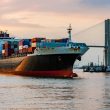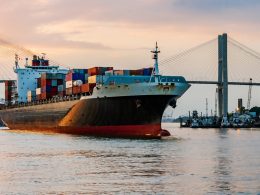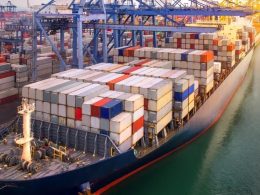by Hubert Marleau, Market Economist, Palos Management
April 25, 2025
Last week, I wrote: ‘The U.S. does not have a divine right to success: this fact has put in question America's long standing role as the world’s leading market. It may be a blip, but based on Trump’s apparent willingness to pause some of his tariffs, and by demonstrating that he is attuned to the scruples of the capital markets, it is indeed possible that peak uncertainty has already passed. There is a large contingency of market strategists who are of the view that market and industry will keep on pushing and prodding the Administration until Trump finally capitulates and essentially reverses the whole thing, other than the basic 10% tariff rate on the whole world except Canada and Mexico. China, however, will definitely not be so lucky. In this regard, Bloomberg's index of trade-policy uncertainty has started to decline. While this is great, concerns remain that the American brand has nevertheless been tarnished. Indeed, America’s international reputation has already been seriously damaged, and the resilience of the American economy considerably undermined. Big foreign customers of Treasuries, who currently hold about a third of this $30 trillion market, could accelerate their selling, wanting less of what America actually exports the most:US debt. This is bound to increase US Treasury term premia, thereby raising borrowing costs for US taxpayers more than they ought to. The sharp devaluation of the US dollar so far this year is an indication that global money managers at margin might be losing some confidence in the U.S. as a place to invest and trade. Incidentally, the real rate on 10-year Treasuries has risen 50 bps since April 2 to 2.28% under a deteriorating economic outlook, suggesting that the entire rise was caused by term premium. US officials are undoubtedly worried about this situational risk reaction, and have initiated discussions with money market banks for a rule change to increase the capacity of the bond market to handle large-volume days during periods of stress. The point is that the Americans do not have a divine right to success anymore than the Spartans, the Romans, the French, the Dutch, the Spanish, the Mongolians, the Ottomans or the British believe they had at one time.’
Ignorance Does Not Get It, But Intelligence Does
Trump supporters essentially refuse to admit that under a classical liberal economic order, where cooperation exists, all countries win. Yet, this truism has deep theoretical roots that are supported by valid theories and empirical evidence. Under Ricardo's law of “comparative advantage” and Adam Smith’s existence of the “invisible hand”, the allocation of resources is more efficient, thereby tending to reduce inflation and promote economic growth. Given that the demand for internationally traded goods and services, perhaps with the exception of energy products and Google search services, is price elastic, meaning that a fall in spending will be far greater than associated tariff-caused price increase, resulting in a drop in total revenues. Instead, they contend that trade is a zero-sum game in which every transaction involves winners and losers. This spurious notion is completely opposite to the economic premise that trading money for goods is mutually beneficial to both buyer and seller.
Maybe Trump drank too much Kool-Aid. Yuval Harari has cleverly figured out what his vision is: “In a Trump world, international agreements, organisations and laws cannot be anything but a plot to weaken some countries and strengthen others. Trump’s ideal world is a mosaic of fortresses, where countries are separated by high financial, military, cultural and physical walls, foregoing the potential of mutually beneficial cooperation but offering countries more stability and peace. There is, of course, a key component missing from this vision. Thousands of years of history teach us that each fortress would probably want a bit more security, prosperity and territory for itself, at the expense of its neighbours. In the absence of universal values, global institutions and international laws, how would rival fortresses resolve their disputes? Trump’s solution is simple: the way to prevent conflicts is for the weak to do whatever the strong demand. According to this view, conflict occurs only when the weak refuse to accept reality. War is therefore always the fault of the weak. Thus consideration of justice, morality and international law are irrelevant, and the only thing that matters in international trade relations is power. So the weaker economies must surrender to stronger ones to assure peace.”
It is mind-boggling that the Trump team, who say that they are in the know, fail to see the trade deficit for what it is, targeting the symptom rather than the root cause, which is persistent budget deficits stemming from fiscal profligacy. This has to do with the so-called twin deficits and the allocation of foreign capital. Americans spend more money than they earn and don't save enough to fund investments. Why? The national output is insufficient to meet domestic demand and domestic savings are inadequate to accommodate investment needs: the Federal Government is spending $2.0 trillion more than it collects from taxation revenue, of which $1.0 trillion is funded with domestic savings and the other $1.0 trillion with foreign capital. Put simply, Americans have more income than their economy can produce, forcing them to purchase foreign goods while foreign and domestic capital end up financing the government deficits rather than useful and productive investments. Put another way, closing the current account deficit would require more savings on the part of Americans, like higher corporate profits and personal savings, but the real key is to reduce government spending. America’s trade and budget deficit problems are its own.
Maybe the Administration is itself drinking too much Kool-Aid by failing to see that the US may be the one who will be the big loser, if it continues on this path of terrorizing its trading partners with wild tariff rates. Denying that prosperity has everything to do with knowledge and the liberty to use it productively is what may do the US in. In this connection, winning this adversarial approach to trade policy may prove to be more difficult than what Trump and company are banking on.
- Acting as a world disruptor, the global sentiment for American brands has changed for the worse. No longer being a reliable ally, many countries may become less willing to accept US demands.
- Trump faces the risk of losing part of his base if prices rise and/or the level of economic activity falls, unmistakably stemming from higher tariffs. Grumbling can already be heard at the periphery of the GOP, slowly draining the Administration of its political capital. Riots are now common all over the US.
- There is no guarantee that foreign businesses will actually respect their soft commitment to make direct investments until the trade war is over for good, and a trusted system is in place to arbitrage disputes.
- The US negotiating hand is much weaker than Trump imagines. The rest of the world (ROW) accounts for 85% of the global economy while the U.S. share of global trade is only 13%, of which a big chunk is agricultural and energy products that are relatively easy to replace.
- Presidents have from time to time to be guided by defunct economists, who in time are noticed and then sacked. Peter Navarro has been called a moron by Elon Musk, the trusted friend of Trump.
- China may not be the first one to blink in the US-China war. President Xi Jinpinghas dug in and promised to fight to the end. He can play good cards: China holds a stash of Treasury bills and is a formidable foe, with trade clout and a network of allies around the globe to promote the idea that Beijing is a better alternative to deal with than Washington.
- Corporations are apprehensive, with consumers already stretched out, that tariffs on the scale Trump is pondering would lead to a profit crunch of intolerable proportions.
- International travellers are consciously avoiding the U.S. The shunning is widespread and could cost the American economy as much as $90 billion.
- A recent survey by the Pew Research Center has conclusively determined that Trump’s approval rating has fallen: 60% of respondents disapproved of his stand on job performance and tariffs alone.
- Last week, California filed a suit against the Trump Administration over what it calls illegal tariffs, and asked to halt all levies immediately; 12 more states joined this week. There is widespread - largely bipartisan - sentiment that the Administration would have to end them if a federal court deemed them illegal: 78% of the respondents of the Pew Survey said that the Trump Administration should and would have to follow a federal court ruling, rising to 88% if the Supreme court were to issue the ruling.
These 10 aforementioned factors are reasons among others to explain why the bulls see a Trump pivot coming on tariffs.
I’m not in the know, and therefore incapable, of putting any tariff numbers on what we are going to end up with. What it does look like, however, is that Trump is executing a tariff-reversal in stages, amid the harsh reaction of the financial markets, broad condemnation by business, and sharp rebuke from the rest of the world. Finally, listening to economic reality, heeding to the polls, the verdicts of David Ricardo and Adam Smith, and realising that US diplomatic sway is rapidly ebbing, my bet is that Trump will settle for a 10% tariff rate across the board and an extra 25% tariff rate on a few specific industries that are judged militarily strategic.
So What Went On Last Week ended April 25?
Over the weekend, the news was consumed by reports that China was not about to yield to American tariff pressure, warning countries against making deals with the U.S. at its expense and by rumors that the US Administration wanted to undermine the independence of the Federal Reserve. The Commerce Ministry said: “China will take countermeasures in a resolute and reciprocal manner.” This threat appears to be a response to a Bloomberg report, citing that the Trump Administration was comtemplating to put pressure on nations seeking tariff reductions or exemptions from the US to curb trade with China, including imposing monetary sanctions. Meanwhile, Kevin Hassett, White House economic adviser, said that President Trump and his team were trying to figure out if they could legally oust the Federal Reserve Chair Jerome Powell.
On Monday, the mood was blue. Stocks resumed their losing ways and so did the dollar and Treasuries, fearing that Trump might get a tacit green light from the Supreme Court to move against Powell. Instead of cooling his jets, Trump slammed the Fed harder. Although an amended version of the Federal Reserve Act makes it possible to remove a Fed governor, this can only be done for cause. Since there is no cause, removal would have to be Powell's decision alone. The situation created stress, as a result of which the S&P 500 tumbled 2.4%.
On Tuesday, US Treasury Secretary Scott Bessent told investors that the tariff standoff with China resembled a trade embargo, which was unsustainable. For the good of the world, a de-escalation should be expected, he added. Moreover, the narrative about the sacking of Jerome Powell as Chair of the Fed changed for the better. Counsel to Trump boldly told him to keep him in place because he would be the scapegoat, the person to blame, if the economy faltered: getting a pet Fed chair, Trump would own every bit of whatever happened subsequently. Tension eased, however, as Trump declared that he had no intention of firing Powell and there was no way that the tariff rate on China would stay so extremely high. The S&P 500 promptly surged 2.5% to finish at 5287.
On Wednesday, President Trump backpedaled more, totally rethinking his tough stance on both Chinese trade and the Fed. The S&P 500 closed with back-to-back gains, rising 1.7% and closing at 5476.
On Thursday, stocks picked up still more steam, even after a 2-day rally, amid consideration that China might suspend its 125% tariff rate on some US imports, casting hope on a resolution to the trade war, along with suggestions by the Fed that rate cuts were possible. Optimism around corporate earnings grew, as did the S&P 500, which increased 2.0% to 5485, exiting correction territory.
On Friday, a strong pick up in the tech sector, a drop in bond yields, and positive remarks on taxes by Trump pushed the Benchmark to 5525, up 0.7%.
The Near Term StockMarket Outlook
On February 14, 2025, the S&P 500 touched a high of 6144; the foreign exchange value of the US dollar expressed in the DXY index was 106.75; and the price of crude oil, gold, and bitcoin was $70.62, $2896 and $98012 respectively; while the yield on 5-year Treasuries was 4.33%. A lot has happened in the 70 days ended April 25, 2025. During this period, the S&P 500 fell 10.1% to 5525, the DXY decreased 6.7% to 99.56, oil declined 10.5% to $63.20, gold increased 14.3% to $3319, and bitcoin lost 2.7% to $95352, while yield on 5-year Treasuries ebbed 45 bps to 3.88%. Interestingly, the swap market is presently predicting that inflation will be running at an annual rate of 3.25% next year versus 4.00% 70 days ago, while the real rate fell from 1.75% to 1.50%. Interpreting that bunch of market-numbers may appear impossible, yet it signals lower growth and inflation than previously expected, in anticipation of 2 rate cuts by the Fed, lower foreign demand for American exports, and less hoarding of dollars as a reserve. In my judgement, there is not enough here to alter my view that the S&P 500 is stuck in a trading range between 5250 and 5500. Earnings for Q1 look attractive, but the reluctance of corporate bosses to offer guidance until the tariff situation is resolved should prevent investors from leveraging above 5500. In this connection, there is not much that investors can do right other than sit tight and hold their ground, and perhaps add to their positions to lower their cost averages.
Copyright © Palos Management














